October 19, 2007
Air Date: October 19, 2007
FULL SHOW
SEGMENTS
Clean Water Anniversary
/ Jeff YoungView the page for this story
The Clean Water Act turns 35 years old this month. American rivers, lakes, and wetlands are a lot healthier than they were before the law’s inception. But the act’s goal of “fishable, swimmable” waterways has still not been realized. Jeff Young reports on the success and shortcomings of the Clean Water Act. (05:00)
Winning the War On Cancer?
View the page for this story
While overall death rates from cancer are dropping, the number of new cancer diagnoses is on the rise, especially among children, African Americans and Native Americans. Dr. Devra Lee Davis is the director of the Center for Environmental Oncology at the University of Pittsburgh. She tells host Steve Curwood about her new book “The Secret History of the War on Cancer” and about why cancer rates are increasing. (06:30)
Emerging Science Note
/ Amy FishView the page for this story
Amy Fish reports that the ingredient that gives vinegar potato chips their tangy taste may prove to be a powerful waterproof sealant for concrete. (01:40)
Development's Carbon Cost
/ Ashley AhearnView the page for this story
Some states and local governments are calling on developers to calculate the climate impact of their development projects. As Living on Earth’s Ashley Ahearn reports, measuring the greenhouse gas emissions from the loss of trees or new construction may be the first step to limiting the emissions. (06:30)
Home Ground
/ Pattiann RogersView the page for this story
In our continuing series on language of the American landscape from the book “Home Ground” edited by Barry Lopez and Debra Gwartney, poet Pattiann Rogers of Colorado defines the term “drumlin.” (02:40)
Who's Your Daddy?
/ Bruce GellermanView the page for this story
A unique research project dubbed "The moon shot of anthropology" promises to answer one of humankind’s most profound philosophical questions: where do we come from? Living on Earth's Bruce Gellerman tests his own DNA and learns about The Genographic Project. (06:30)
Cool Fix for a Hot Planet
View the page for this story
A California listener shares two ways she and her husband are saving energy. (02:10)
Big Oil, Good PR?
View the page for this story
At two and a half minutes in length and a cost of tens of millions of dollars, Chevron’s new television spot aims to show the company’s human face and good intentions. Boston University Communications Professor John Carroll listens to the ad with host Steve Curwood about talks about big oil’s big push to look green. (04:15)
Javatrekker
View the page for this story
Dean Cycon believes coffee farmers should receive a living wage and has traveled the world to help build the fair trade movement. Cycon imports and sells coffee under the name “Dean’s Beans” and recently wrote a book about his adventures in the coffee trade called “Javatrekker: Dispatches from the World of Fair Trade Coffee.” He joins host Steve Curwood. (11:10)
This week's EarthEar selection
listen /
download
A rolling thunderstorm in a Brazilian rain-forest.
Show Credits and Funders
Show Transcript
HOST: Steve Curwood
GUESTS: John Carroll, Dean Cycon, Devra Davis, Connie Freed
REPORTERS: Ashley Ahearn, Bruce Gellerman, Jeff Young
[THEME]
CURWOOD: From Public radio International, this is Living on Earth.
[THEME]
CURWOOD: I’m Steve Curwood. The good news about cancer is that overall death rates are dropping. But the bad news is the number of cancer cases is rising, especially among children. One leading scientist says that’s because too many polluters have gotten free rein.
DAVIS: There was this naive belief that the companies and the people running them would do the right things and while sometimes they did, often they did not.
CURWOOD: Also, tracing our ancestors back to the small band of humans who managed to survive a population crash more than 50,000 years ago.
WELLS: We actually went through a near extinction event. The total human population, according to our calculations based upon genetic variation, dropped down to two thousand people so we were hanging on by our fingernails.
CURWOOD: These stories and –the Clean Water Act turns 35. We’ll see how well it’s doing. That and more this week on Living on Earth. Stick around!
ANNOUNCER: Support for Living on Earth comes from the National Science Foundation and Stonyfield Farm.
[THEME]
Clean Water Anniversary

The Anacostia River drains 176 square miles of D.C. and Maryland. 70 percent of the wetlands have been lost over the last 250 years.
CURWOOD: From the Jennifer and Ted Stanley Studios in Somerville, Massachusetts, this is Living on Earth. I’m Steve Curwood.
Until the early 1970s many of the nation’s rivers were virtually open sewers. Near Cleveland, the Cuyahoga River was so polluted it repeatedly caught fire. Today, lakes and rivers are much cleaner—thanks to the Clean Water Act. But some 40 percent of the country’s waterways still do not meet clean water standards. As the Clean Water Act turns 35 years old this month, Living on Earth’s Jeff Young reports it’s starting to look a little gray.
[SOUND OF WATER LAPPING]
YOUNG: James Lindsey watches his fishing line from the banks of the Anacostia River. The 53-year-old grew up here in Washington’s southeast and remembers when he wouldn’t come this close to the river.
LINDSEY: Used to be pretty dirty. You know, you could smell the filth, back in the day. You know and it could be better, it could be better. But it’s improved a whole lot, a whole lot.
YOUNG: It might be better now but Lindsey still should not eat the fish he catches. And swimming? That’s not safe, either, especially after a heavy rain. Part of the problem is just steps away, where a thin man in khakis and glasses pokes around a large pipe.
LEHNER: This is a combined sewer overflow discharge point. It is where on rainy days, unfortunately, raw sewage will be discharged into the Anacostia River.
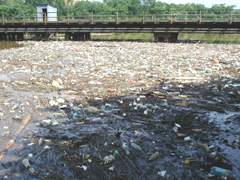
A carpet of trash on the Anacostia River, Southeast, DC. (Courtesy of Anacostia Watershed Society)
LEHNER: Frankly, the runoff is the major failure of the Clean Water Act. It’s the major reason why still thousands of miles of waters are still not as clean as they should be.
YOUNG: From the little Anacostia to the mighty Mississippi, runoff –or nonpoint-source pollution—is the big threat. A new report from the National Academy of Sciences says the federal government should more aggressively use the Clean Water Act to combat nutrient pollution from fertilizer used on farms and fields. Purdue University agricultural economics professor Otto Doering helped write that study. Doering says the Act has done a good job on industrial discharges, called point sources.
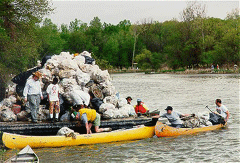
Anacostia River cleanup, Earth Day 25 - April 1995(Courtesy of EPA)
YOUNG: The Academy report says there aren’t water quality standards for many stretches of the Mississippi and even monitoring data is lacking or not well coordinated. Doering says the Clean Water Act has not yet been fully applied to the problem of nutrient runoff. The result is a dead zone where marine life can’t live in low-oxygen waters where the river hits the Gulf of Mexico.
DOERING: The act was designed for those things that the public perceived as the 800-pound gorilla. We’ve done fairly well with that 800-pound gorilla. Now we’ve got another 800-pound gorilla.
YOUNG: The Clean Water Act also has problems upstream. Recent Supreme Court decisions limit the act’s authority over small streams and wetlands. And then, there’s the flow of money—or, rather, the lack of it. Federal funding for Clean Water projects like water lines and sewage treatment has dropped some 60 percent since the early 1990s, even as aging infrastructure is starting to break down. Oregon Democratic congressman Earl Blumenauer wants a long-term source of steady funding.
BLUMENAUER: If we’re able to establish a trust fund that is $10 billion, does that solve a long-term problem that is considered—by any estimate—is over half a trillion dollars? No. But it is significantly more than what we are doing now.

The Anacostia River drains 176 square miles of D.C. and Maryland. 70 percent of the wetlands have been lost over the last 250 years.(Courtesy of EPA)
YOUNG: Blumenauer says there’s broad public support for programs to help farmers reduce agricultural runoff and to help cities like Washington help keep the runoff from streets from causing sewage spills.
[SOUND OF WATER LAPPING]
YOUNG: Back on the banks of the Anacostia, Peter Lehner wonders when that support
will start to trickle down.
LEHNER: One would think that the capital lawmakers would care more about the river that goes through their backyard, but they seem not to. It might not catch fire like the Cuyahoga River did in 1972. But it’s certainly not swimmable, yet, even though the Clean Water Act’s goal is to have everything swimmable. It’s sad; they haven’t been willing to invest in our public infrastructure.
YOUNG: After 35 years with the Clean Water Act, all our rivers might not be fishable or swimmable, but at least they’re no longer flammable.
[MUSIC: Randy Newman “Burn On” from ‘Sail Away’ (Rhino—2002)]
YOUNG: For Living on Earth, I’m Jeff Young in Washington.
[MUSIC: Randy Newman “Burn On” from ‘Sail Away’ (Rhino—2002)]
Related links:
- EPA on the Clean Water Act, its history and implementation
- Food and Water Watch report on funding the Clean Water Act
- National Academies on the CWA and the Mississippi
- Anacostia Watershed Network
- NRDC: Cleaning up the Anacostia
Winning the War On Cancer?

Dr. Devra Lee Davis is Professor of Epidemiology at the University of Pittsburgh's Graduate School of Public Health. (Courtesy of University of Pittsburgh)
CURWOOD: There’s no news quite like good news, and in recent days we’ve heard the good news that more and more people in America are surviving cancer. Overall cancer death rates are dropping—about two percent a year—and that translates into about 10,000 lives being spared.
But not everyone is part of the good news. Cancer death rates continue to rise for African Americans and Native Americans and the incidence of cancer is rising in the general population. And it’s not just that the U.S. population is aging. Age-adjusted cancer rates still show a rise. The big question is: why? Radiation and many chemicals are known to trigger cancer and this is where the fight should begin, say many scientists, including Devra Davis. She’s the director of the Center for Environmental Oncology at the University of Pittsburgh and has written a new book, “The Secret History of the War on Cancer.” Nice to speak with you again, Dr. Davis.
DAVIS: Thank you so much, Steve.
CURWOOD: In the news we’ve been hearing that the death rates for cancer have been dropping. What does this mean?
DAVIS: Oh it’s great news. It means that fewer white men are smoking. It means that we’re getting better at finding and treating colorectal cancer and breast cancer. But there’s another part of the story that hasn’t been told that we need to be aware of and that is that new cases of cancer—or incidence—have increased for some forms of cancer that have nothing to do with smoking and nothing to do with aging. For example, childhood cancer has increased about 20 percent since 1975 up to 2003. And childhood cancer, after accidents, is the leading cause of death in children.
CURWOOD: So what you’re saying is we’re now seeing more cancer, but fewer people are dying from it?
DAVIS: Well we’re not seeing more cancer even, because we’re not seeing more smoking-related cancer. We’re not seeing, for the first time, more breast cancer. We’re not seeing, necessarily, more colorectal cancer. In those cases, in the case of smoking—because fewer people are smoking, actual rates of cancer are dropping.
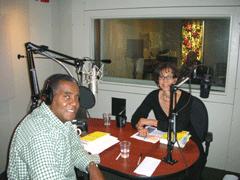
Devra and Steve in the studio.(Photo: Emily Taylor)
DAVIS: We have good news about those cancers going down. We have some bad news, though, because they’re not going down equally for everybody.
CURWOOD: Oh?
DAVIS: And the patterns of cancer are much worse for blacks than whites. While one in eight Americans is black, one in two who works in sanitation is black, one in three who works as a bus driver or in a dirty factory job is black, and one in four who lives near a hazardous waste site is black. So when you see the higher burden of cancer for blacks, we have to ask whether they are dietary or environmental factors that might account for it.
CURWOOD: Now where are things not improving or even getting very worse?
DAVIS: Well testicular cancer, I think, is a good example. It’s, unfortunately, the most common cancer in young men. Fortunately, it’s rare. Unfortunately, it’s less rare. Throughout the industrial world today, testicular cancer has increased 50 percent in every country where we’ve looked.
CURWOOD: Why?
DAVIS: One of the theories is that there are things that disrupt hormones and disrupt signals when the testes are developing in utero, or early in life. And that these chemicals or other things that can affect the development of the testes kick in so that when the testes reach its mature growth, in young men in their 20s, that’s when testicular cancer is manifest.

Dr. Devra Lee Davis is Professor of Epidemiology at the University of Pittsburgh's Graduate School of Public Health. (Courtesy of University of Pittsburgh)
DAVIS: Well I was shocked as I started to research this book “The History of War on Cancer,” that in 1936 the world’s leading cancer scientists understood that tobacco caused cancer, hormones caused cancer, x rays caused cancer, solar radiation caused cancer, benzine caused cancer, coal tars caused cancer. Now they knew that in 1936 and I’m not talking about a small, little group. This was the world’s leading experts in the field. And it was fascinating for me to see how the shift of what was considered evidence about cancer causes occurred shortly after this.
CURWOOD: Who decided to use these substances even if science knew that they caused cancer and why?
DAVIS: There was a general lack of information about the causes of cancer except among the very well informed. You have to remember that well into the 1960s and 70s and continuing now with pharmaceutical research, research was done paid for by companies and they owned the research. They could determine when it got published and what got released.
CURWOOD: So what you’re saying is that in certain cases, companies went ahead making and distributing and using these products in full knowledge that they would make people sick.
DAVIS: That is correct.
CURWOOD: So what’s the failure here?
DAVIS: Well I think, as the cartoon Pogo said, the failure is—we’ve met the enemy and it is us. We’re all responsible for this. We had a government that eagerly wanted to believe that industry knew best. We had industry that thought that it could make these decisions and make them in our collective best interest. And we had a public that was not informed and didn’t know enough to ask.
CURWOOD: So what can we do to get the various products and other forms of exposures away from us?
DAVIS: I think we have to take a harder look at what we are doing and I call for a truth and reconciliation commission on toxic hazards.
CURWOOD: So, in South Africa that meant that people came forward and told all the horrible stories and they would not be prosecuted.
DAVIS: I don’t know what the system would look like. I want to put the idea out there for discussion but one of the things it would do, is if companies agreed to come forward with what they know about toxic hazards now, they would be immunized from punitive damages. There’s no incentive for companies to do this right now. The adversarial system isn’t working. There’s in fact incentive for companies not to give us information. If we had a truth and reconciliation commission, if we had a neutral forum where information was provided, that could be independently reviewed, then we’d have a much better opportunity to identify the problems that we can do something about now.
The current system isn’t working. What we are saying increasingly is—particularly in this administration—is that the only way we know something is a cause of cancer in humans is when we have enough sick or dead people accumulated that we can definitively say: ‘they have incurred a risk.’ Think of what that means. What that means is that we are dooming this current generation to getting cancer before we decide to act to prevent future generations from getting less of it. And I think that’s fundamentally wrong.
CURWOOD: Devra Davis’ new book is called “The Secret History of the War on Cancer.” Thank you so much, Dr. Davis.
DAVIS: Thank you, Mr. Curwood.
[MUSIC: Various Artists “Daphne” from ‘1 Giant Leap’ (Palm Records—2001)]
Related links:
- The 2007 report on the status of cancer
- "The Secret History of the War on Cancer"
- University of Pittsburgh Cancer Institute's Center for Environmental Oncology
CURWOOD: Coming up—assessing the global-warming impact of real estate developments. Keep listening to Living on Earth.
CURWOOD: It’s Living on Earth. I’m Steve Curwood. Just ahead: going back to our genetic roots. But first this Emerging Science Note from Amy Fish.
Emerging Science Note
[SOUND OF PLASTIC BAG OPENING]
FISH: Mmm. Salt-and-vinegar potato chips. Bet you can’t eat just one. And soon, the ingredient that gives these chips their tangy taste may be used to improve our buildings.
[MUSIC: Science Note Theme]
FISH: Sodium acetate is a chemical derived from vinegar. It’s not only used to flavor chips but also to preserve food, treat leather hides, and make the heat in heating pads. And now, two university scientists in Jordan have discovered the chemical’s power as a waterproof sealant for concrete.
Concrete is the most widely used structural material in the world. But its many pores allow water and acid to seep in, which can cause the concrete to crack. Most sealants are not only expensive and short-lived—they’re often toxic to wildlife and humans.
But researchers found that sodium acetate is cheap, long lasting, and environmentally friendly when used as a sealant. Sodium acetate forms crystals that bind tightly to the pores inside concrete. The crystals absorb moisture and swell to fill the pores, which block water from entering the concrete. In dry conditions, the crystals shrink back to their original size, allowing moisture to evaporate.
So sodium acetate may help concrete become water resistant—even if it won’t help you resist that bag of chips.
That’s this week’s note on emerging science. I’m Amy Fish.
Development's Carbon Cost
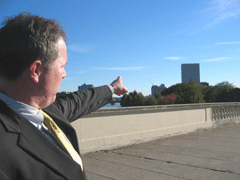
Chris Gordon is overseeing the new Allston development for Harvard University. (Photo: Ashley Ahearn)
CURWOOD: Converting land to new housing or commercial buildings can aggravate global warming. How much depends on what you measure. There are the emissions from heating and cooling of course, but some people also count the loss of trees, or even new, longer commutes. Now some states and local governments are starting to pressure developers to calculate the climate impact of their projects. At the head of the pack is Massachusetts. Living on Earth’s Ashley Ahearn has our story, and she begins with a look at a major expansion at Harvard University.
AHEARN: Chris Gordon is standing on a bridge over the Charles River. He’s pointing across the water to where Harvard University’s about to break ground on a new 200-acre development that will include academic buildings, housing, and community centers.
GORDON: On the right you can see the beginning of the Allston campus, which is primarily the business school now, and then beyond that is where the rest of the new Allston campus will be developed.
AHEARN: Gordon is chief operating officer for the new development. All of the buildings will adhere to top green building standards—solar panels, geothermal heat from the earth, energy efficiency. But one—the new science center—is taking the concept further.
After being approached by the state government, Harvard agreed the science center would take the building industry standard for emissions, and cut that in half.

Chris Gordon is overseeing the new Allston development for Harvard University. (Photo: Ashley Ahearn)
GORDON: Fear (laughs). No, I mean the debate was of course—can you do it? I mean we wanted to do it and we felt we could but we really wanted to do our homework to make sure we could do it.
AHEARN: Managers of all large developments in Massachusetts will be facing similar challenges under a new state policy. Ian Bowles is the secretary of Energy and Environmental Affairs for the commonwealth.
BOWLES: What we did this year was we included for the first time, greenhouse gases in the types of things we’re going to require people to analyze.
AHEARN: Bowles says the new policy asks developers to ask themselves a few questions:
BOWLES: What impacts are you going to have? How much are your emissions going to be, and what are the steps you could take to avoid, minimize or mitigate the damage you may do to the environment?
AHEARN: Major state projects, like the Big Dig for example, will have to go further. They’ll have to account for what are called the lifecycle emissions of the project. These are the emissions from construction, operation of the structure, and transportation to and from the site once it’s up.
That might seem like a pretty comprehensive assessment—and in the urban world, it is. But Dan Sosland, head of the nonprofit Environment Northeast, says that if you head to the wilder parts of the country, the greenhouse gas picture isn’t complete without factoring in how the landscape will be changed.
SOSLAND: If we don’t pay attention to the loss of forests, the steps that we’re taking to reduce emissions in other areas are going to be neutralized, in effect, by increased emissions from these developments.
AHEARN: The Plum Creek Timber Company, the largest private landholder in the country, has plans for an over 20,000-acre development along Moosehead Lake in Maine’s north woods. Sosland and Environment Northeast decided to assess the greenhouse gas emissions of the proposed development and produced a report.

Dan Sosland is the head of Environment Northeast
(Courtesy of Environment Northeast)
AHEARN: Luke Muzzy is a spokesperson for Plum Creek Timber.
MUZZY: This has never been discussed before as part of the permitting process. I don’t believe it has been in any development in the state of Maine. Global warming is a serious concern for everybody. I mean it is for me personally, but I also realize that areas like mine have got to grow and there is going to be development.
AHEARN: Other builders and developers are just beginning to address this trend. The National Association of Home Builders says it's studying the issue.
Judi Greenwald, a policy analyst at the Pew Center on Global Climate Change, says the carbon cost of development is beginning to register with policymakers around the country.
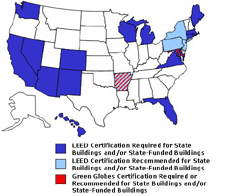
Building standards, state by state.
(Courtesy of Pew Center on Global Climate Change)
GREENWALD: As we’re all starting to sit up and pay attention to how to reduce greenhouse gas emissions people are using whatever tools they can find.
AHEARN: In California, Attorney General Jerry Brown ignited a firestorm this summer, when he tried to force local governments to count greenhouse gases when they make growth decisions that are going to create new longer commutes. Republicans in the legislature were so angry it led to a budget stalemate for two months.
King County, Washington has added greenhouse gas pollution to its project review and the state of Washington plans to follow suit. The District of Columbia also plans to require developers to calculate greenhouse gas emissions.
GREENWALD: This is another example of states and localities filling this federal vacuum that we have, and they’re also playing an interesting role as laboratories, which they often do on a lot of policy arenas in the United States.
AHEARN: Lab rats or not, the sudden attention to climate change is inspiring ideas that would have seemed far fetched just a few years ago. Counting tons of CO2 from developments, some say, could be the first step towards limiting them.
For Living on Earth, I’m Ashley Ahearn.
[MUSIC: Daniel Lanois “O’Marie” from ‘Acadie’ (Daniellanois.com—2005)]
Related links:
- Environment Northeast's Assessment of the Plum Creek Development in Maine's North Woods
- The Pew Center on Global Climate Change tracks regional and state activity on greenhouse gases
- Press Release from Massachusetts Secretary of Energy and Environmental Affairs on the Greenhouse Gas policy
Home Ground
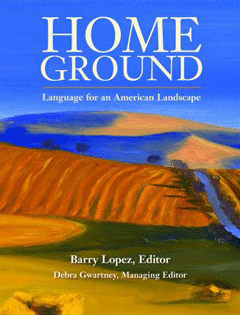
Home Ground: Language for an American Landscape, edited by Barry Lopez and Debra Gwartney. (Courtesy of Trinity University Press)
CURWOOD: Picture a place you love. What you see in your mind is more than the simple sum of its parts. There's an intimacy, a special relationship we have with the land and the forms that are dear to us, even as they change.
Writers Barry Lopez and Debra Gwartney asked 45 authors to write about their geological perceptions. These accounts are part of a volume called "Home Ground - Language for an American Landscape." We've asked several writers to read from their entries. Today, Pattiann Rogers of Castle Rock, Colorado has her definition of ‘drumlin.’

"Home Ground: Language for an American Landscape", edited by Barry Lopez and Debra Gwartney.(Courtesy of Trinity University Press)
ROGERS: Drumlin. Drum is a Scottish term meaning a narrow hill or a long ridge. A drumlin, derived the Irish-Gaelic ‘druin,’ is a long, elongated oval hill of glacial drift, composed mainly of boulder clay or glacial sands and gravels. Drulins are sometimes described as having the shape of inverted spoons and though their genesis is debated, they are believed to have been formed when glacial ice, moving over the land, compressed the earth into specific patterns. The long axis of a drumlin is parallel to the direction of former ice movement, while the steep end faces the direction from which the glacier advanced. Drumlins often appear in groups called ‘fields,’ ‘pods,’ or ‘swarms.’ Three thousand drumlins lie in southern New Hampshire and eastern Massachusetts and close to 11,000 drumlins lie in New York between Rochester and Syracuse, north of the Finger Lakes. Some of the drumlins in this area rise to sharp, sloping ridges and are called razorbacks, as they look like razorback hogs sleeping on the open land. ‘Watching the shifting light above the drumlins, I felt a darkening within myself,’ writes Ben Howard in his poem “Midcentury.”
CURWOOD: Pattiann Rogers’ book “Firekeeper: Selected Poems” won the 2005 Lannan Award for Poetry. Her definition of "drumlin" is in the book "Home Ground: Language for an American Landscape," edited by Barry Lopez and Debra Gwartney.
[MUSIC: Leo Kottke “The Sailors Grave On The Prairie” from ‘6 And 12 String Guitar’ (Fantasy Records—1974)]
Related link:
Home Ground: Language for an American Landscape
Who's Your Daddy?
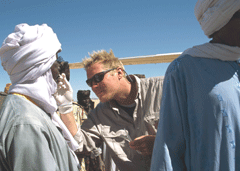
National Geographic Genographic Project Public Participation Kit. (Photo: Becky Hale)
CURWOOD: Researchers are about half way through one of the largest science projects in history. Technically, it’s called “The Genographic Project,” but it’s been dubbed “the moon shot of anthropology.” When it’s finished in 2010 scientists will have created the most detailed database ever; mapping the journey humans have made over the millennia as we’ve populated our planet.
You too can become a part of this unique, international research effort as Living on Earth’s Bruce Gellerman learned when he met the head of the Genographic Project.
GELLERMAN: When it comes to adventure and travel, Spencer Wells has a job even Indiana Jones would envy. Wells is explorer in residence for the National Geographic Society—not that he resides anywhere all that long.
WELLS: Just this year alone I’ve circled the globe twice since April. I get a lot of frequent flier miles (laughs).
GELLERMAN: Globe-trotting Dr. Wells is a population geneticist. As director of the Genographic project, he travels to isolated and exotic places in search of indigenous people—people who have pretty much stayed in one place for a long time. When he finds them, Wells tries to convince them to donate a sample of what makes them human: their DNA.

Chad, November, 2005: Spencer Wells collects a cheek swab from a participant in Chad.(Photo: David Evans © 2006 National Geographic)
GELLERMAN: Project researchers at ten centers around the world are collecting genetic samples and tracking mutation markers from a hundred thousand indigenous people—with different skin colors, blue eyes, brown eyes, tall and short. Dr. Wells says scientists are hoping to answer a profound philosophical question: Who’s your daddy?
WELLS: The big surprise, again and again and again, is that despite this incredible diversity, we see around the world—the 6,000 languages and the different physical appearances and so on—we’re all incredibly closely related. We’re 99.9 percent identical at the genetic level.
GELLERMAN: That’s because we share distant common ancestors. Researchers can genetically trace all of the planets 6.5 billion people to one man and one woman. They call them Adam and Eve. They lived in the highlands of east Africa. But 74,000 years ago something dramatic happened that really shook up the gene pool.
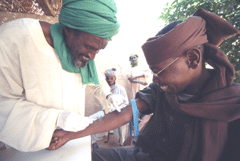
Chad, November, 2005: A local health worker takes a blood sample from an indigenous volunteer in Chad. (Photo: David Evans © 2006 National Geographic)
GELLERMAN: Dr. Wells believes the massive die off of modern humans was caused by an ice age triggered by the eruption of a super volcano on the island of Sumatra.
WELLS: The idea is that probably climate was a driving force and the climate was getting really bad at that time and it was tough to find food. And the human population crashed. And we came back from that.
GELLERMAN: Our adaptable genes saved our species. Our mix of brain and brawn changed. We developed more intelligent ways of hunting, learned to make better tools, and developed language. Our ancient ancestors moved out of Africa and began spreading across the globe. It’s all there—our genetic markers map our migration. The stories told by DNA samples collected from all points on the compass.
[DRUMS]
GELLERMAN: In the wilds of Cambridge Massachusetts at the Museum of Science, a crowd of urban dwellers has come to hear Dr. Wells talk about his project—and maybe participate in it.
[SOUND OF CROWD OF PEOPLE]
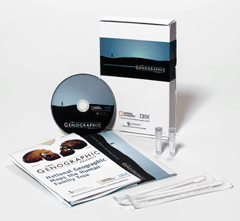
National Geographic Genographic Project Public Participation Kit. (Photo: Becky Hale)
DHEILLEY: I know about 25 generations of my family on one side that I sort of chase back a thousand years ago. So I’m like, ‘whoa, this would be really cool,’ to be able to see that we’re really all cousins—at most 2000 generations removed.
GELLERMAN: The Genographic test kits are a high-tech way to participate in the project, but at the Museum of Science there’s also a low-tech method. You can taste test your place on the migratory map. Duane Hill works at the museum’s human body connection exhibit, where you can trace your genetic origins using a chemical called PTC.
HILL: PTC is actually a small little molecule, a tiny little molecule. But what we found is that it has very similar shape to some of the molecules that are in the foods that we like to eat or that we don’t like to eat.
GELLERMAN: PTC tastes bitter. Hill says as we migrated out of Africa, the plants we encountered changed. And so did our taste buds.
HILL: I actually have a piece of PTC paper right here.
GELLERMAN: All right, what do I do?
HILL: All you have to do is lay it out on the tip of your tongue and tell me what you taste. What do you taste?
GELLERMAN: Bitter.
HILL: Bitter. You’re a taster. You’re a pretty strong taster. You told me that you tasted it pretty quickly.
GELLERMAN: So according to Hill, on the taste test map that puts my ancestors somewhere in East Europe or the Americas. To pinpoint more exactly, I got one of those genographic test kits and scraped the inside of my mouth for DNA.
[SOUND OF GELLERMAN SCRAPING HIS MOUTH AS HE TRIES TO TALK]
GELLERMAN: I sealed the genetic sample from my cheek in a small vile and sent it to the National Geographic Society for analysis. Project director Spencer Wells says the test kits are a new model for doing science, a collaboration between scientists, indigenous people, and the general public. It’s real-time, interactive research. Money from the sale of the kits will finance the Legacy Fund, an educational project to preserve and protect our genetic and cultural diversity.
WELLS: We’re going through a period of cultural homogenization all over the planet right now. We’re losing languages at an incredible rate—one every two weeks. And we want to do something to raise awareness about that, something to give back to these indigenous groups that we’re collaborating with. You know if we don’t do something to try and save these things we will have lost a huge part of who we are.
GELLERMAN: I’ll find out more about who I am and who’s my daddy in a few weeks when my DNA test results come back from the genographic project. For Living on Earth, I’m Bruce Gellerman.
Related link:
The Genographic Project
Cool Fix for a Hot Planet
[COOL FIX THEME]
CURWOOD: In our segment “Cool Fix for a Hot Planet” we’re highlighting ways you can make a difference. Connie Freed of Napa, California emailed us about some ways her family is fighting global warming, and we gave her a call.
FREED: My husband and I have two ways that we developed to save energy here. We’ve always realized that our oven is a major source of heat in the summer when we do not want any heat whatsoever in our house and so what we’ve had to do is to avoid baking from anything from June through the end of September. And then he came up with the idea of buying a small convection oven and putting it outside on our covered porch. And we’ve used it all summer long. It’s great. It doesn’t need as nearly the energy of our oven and for people who have air conditioning you wouldn’t be producing heat while at the same time trying to cool your home.
And my husband’s also come up with a second way that is a very low-tech way of saving heat that’s been fabulous. He takes shade cloth, which is available at any large home improvement store, and it looks like green cloth mesh. And we have just fashioned curtains out of it and we hang it outside the window and it blocks the direct sun from hitting your window and heating it up. Even if you have double paned windows this really makes a huge difference we’ve found. It lets in a really nice filtered green light and it provides privacy so you can have your blinds open if you want but you’re still receiving shade on the outside of your home, from this cloth. And those are our two ideas.
CURWOOD: Thanks, Connie. And for that we’re going to send you $432. Well, not exactly. What we will send you is a Living on Earth tire gauge. And if you use it to keep your tires correctly inflated, it could save you as much as $432 a year. So, if you or someone you know has a Cool Fix for a Hot Planet, please let us know. If we use your idea on the air, you’ll get a Living on Earth tire gauge, as well. Call our listener line at 800-218-99-88, that's 800-218-ninety nine, eighty-eight. Or email coolfix (all one word) @loe.org. That's coolfix@loe.org.
Just ahead, traveling the world in support of a fair price for coffee farmers. Stay tuned to Living on Earth.
ANNOUNCER: Support for the environmental health desk at Living on Earth comes from the Cedar Tree Foundation. Support also comes from the Richard and Rhoda Goldman Fund for coverage of population and the environment. This is Living on Earth of PRI: Public Radio International.
Big Oil, Good PR?
CURWOOD: It’s Living on Earth. I’m Steve Curwood. With high gas prices and high oil profits, it’s no wonder the big oil companies top the list of firms Americans love to hate. So, Chevron is the latest corporation to mount a charm offensive.
[CHEVRON AD FADES IN]
VOICEOVER: This isn’t just about oil companies. This is about you and me and the undeniable truth that at this moment there are six and a half billion people on this planet. And by year’s end there will be another 73 million. And every one of us will need energy to live.
CURWOOD: The images for this two and a half minute long ad were shot around the globe and then deftly cut together into a visual cascade of towering glaciers and crashing waves, smiling babies, and teeming cities. Millions of dollars went into the production, and many millions more are being spent to buy airtime.
John Carroll teaches communications at Boston University and is a longtime commentator on advertising. John, what do you make of Chevron’s ad?
CARROLL: It’s a gorgeous spot to look at. They’ve got this constantly shifting imagery that alternates between, sort of people—human emotion—and technology. And what they’re trying to do is that while this voiceover is going on—this voiceover that sounds like the introduction to a Frontline documentary—while this voiceover is going on they are showing images that are probably a lot more powerful and having a lot more impact than anything they’re saying. They are basically showing you and trying to get you to associate in your mind Chevron and this sort of sense of humanity and this sort of sense of connection.
CURWOOD: Now Chevron’s not alone in sort of looking for and trying to create good PR. How does this fit into the PR that the other major oil companies are using?
CARROLL: Virtually everybody’s got at least part of a campaign; some subset of their marketing devoted to this. BP has come out with a series of commercials with people saying ‘we need you to be concerned, BP, about your effect on the environment’ and their response is ‘we are concerned.’ So it’s a nice little call and response for them to go out and be able to say what they’re doing to protect the environment and to increase the energy production responsibly.
You’ve also got a similar situation with Exxon where they’ve got this reinventing-your-wheels campaign. They have the same issues and they have the same concerns that everyone in the industry does and they’re all going out there trying to patch their images. They’re all going out there trying to convince people that they are responsible citizens at this point and they’re providing a necessary service and they’re providing it in the most environmentally sensitive way they can and it’s no use hating them, because you know they’re doing the best they can.
[CHEVRON AD FADES IN]
VOICEOVER: This is our challenge each day. Because for today and tomorrow and the foreseeable future, our lives demand oil. But what’s also true is that we can provide it more intelligently, more efficiently, more respectfully.
CURWOOD: So how much money are they spending on this campaign between the making of this ad and then buying the time to get it in front of people?
CARROLL: The estimates I’ve seen are $40 million internationally that they will spend on this ad. So that’s not an overwhelming amount of money in terms of advertising but it’s a significant advertising if they’re going to do it over a short-period of time and that’s probably the best way for them to do it.
CURWOOD: How well is this ad going to do in terms of making people feel better about the big oil companies? I mean the polls say people don’t like big oil.
CARROLL: They don’t like them and they certainly don’t like the kind of money they’re making these days. I mean they think of them as price gougers and people who are just spoiling the environment when they’re not hanging out with Hugo Chavez down in Venezuela. So they are looking at Chevron with a real sort of jaundiced eye and this is a giant diversion machine that Chevron has produced here. These ads are long term, incremental, they don’t change public images of companies immediately. What they do is they slowly erode the negative image and try to replace it with a positive one.
CURWOOD: John Carroll is a mass communications professor at Boston University and a frequent contributor on advertising in the media for WBGH Boston. Thank you so much, John.
CARROLL: My pleasure, Steve.
MUSIC: Various Artists “Racing Away” from ‘1 Giant Leap’ (Palm Records—2001)]
Related link:
Check out Chevron's "Untapped Energy" commercial on YouTube:
Javatrekker
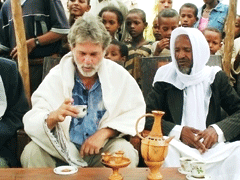
(Courtesy of Dean Cycon)
[WOMAN SAYS ‘CAN I GET A MEDIUM LATTE PLEASE?’ SOUNDS OF CASH REGISTER, MILK BEING STEAMED, PEOPLE TALKING]
CURWOOD: A latte at a coffee bar can cost three or four bucks and almost none of that money gets back to the coffee grower. Indeed, a close look at farmers the world over finds that most of them get poverty-level prices for their crops. And many also run the risk of cancer and other health problems associated with farm chemicals. To change this dynamic the fair-trade coffee movement began. Fair-trade coffee merchants pay better prices by dealing directly with growers instead of middlemen, and by encouraging the production of premium organic coffee.
Dean Cycon helped to build the fair-trade coffee movement. He imports and sells coffee under his brand Dean’s Beans and has just written a book about his adventures in the coffee trade entitled “Javatrekker: Dispatches from the World of Fair Trade Coffee.” Dean, how did you become interested in coffee?
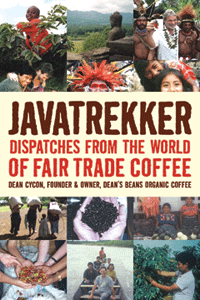
"Javatrekker: Dispatches from the World of Fair Trade Coffee", by Dean Cycon (Courtesy of Chelsea Green Publishing)
CURWOOD: So what you’re saying is that you would raise some money from coffee companies and you’d put in a well or a school or a clinic or something?
CYCON: Exactly. Which is great, but I thought—what would it look like if the companies paid the people enough so that they could make their own development decisions and pay for their own well if they wanted it. What would that look like?
CURWOOD: Now, as I understand it, the coffee plant can maybe only use about 20 or 30 percent of a day’s worth of sunlight—that if it’s out in the sun all day long it’s not actually good for it.
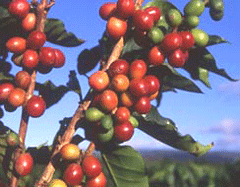
Coffee cherries growing. (Courtesy of the State of Hawaii)
CURWOOD: So, the world is changing in particular, in terms of climate. What’s the effect of global warming been on coffee around the world?
CYCON: Well you know not too many people have looked into that but in February I was in Colombia in particular to look at the impact of global warming on coffee. In this one area in Colombia they believe that they are the elder brothers and their job is to hold the world together so they’re very, very sensitive to ecological change. What they taught me there, is that as the world heats up, the upper mountains are drying up. So what that means is that the water from glacial melt doesn’t make it down the mountain. That means that the nutrients in the soils on top of those mountains, the minerals, don’t make it down. So the soil becomes less coherent down below.
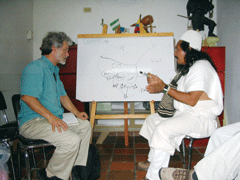
An Arhuako tribal leader in Columbia explains to Dean how climate change is affecting the Sierra Nevada Mountains and the coffee they grow there.
(Courtesy of Dean Cycon)
CURWOOD: Now you’ve traveled to just about every place where people grow coffee. And one of the places I was surprised to hear there’s coffee from was Papua New Guinea.
CYCON: Papua New Guinea is probably one of the most remote places in the world. When I was getting ready to go to Papua New Guinea I couldn’t find anybody who’d ever been there. And, coffee was only introduced to Papua New Guinea like 60 years ago. They took the coffee there and had no problems growing it. Unfortunately, the farmers don’t have access to information on how to process it well. Papua New Guinea is the only place in the world where people take handfuls of coffee, put them on river stones and smash them to get the beans out, as opposed to processing them in machinery and so it’s very uneven. So that coffee can be one of the world’s best, which would change the economics of Papua New Guinea tremendously—if they only got a little technical help, which is one of the things we’re doing there.
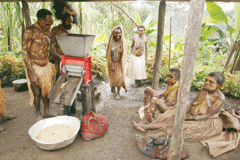
This simple depulper immediately increased the quality and value of the coffee produced by these farmers in Papua New Guinea. (Courtesy of Dean Cycon)
CYCON: Well I was the first white guy to go up into those mountains since the Australian soldiers were there in World War II, which means that the overwhelming majority of the population, which is younger than World War II, had never met a Caucasian, had never met an American, certainly, and had never met anybody who could say something about the quality of and how hey grow their coffee. So my visit set off a furor. I went to one village and there were over a thousand people in traditional dress. I know traditional dress is mostly what they wear but I’m talking about boar tusks through their nose and six-foot-tall feather head sets, the women were only wearing grass skirts and were covered with pig fat and ash, and they were in a mood to celebrate. The next place we went to we were met by 8,000 people in tribal dress and they were going ballistic. And so I got a chance to speak to them and work a lot and they had celebrations showing how to grow coffee and beating the robbers who come and steal the coffee. There were morality plays. It was mind blowing. I’d never had an experience like it in my life.
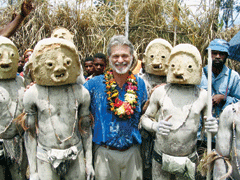
The Asaro Mudmen in Simbu Province welcome Dean to Papua New Guinea.(Courtesy of Dean Cycon)
CYCON: Well I try to learn enough of the language, the indigenous languages when I go someplace, to show respect. And people really appreciate it if I can say even a few words. So I learned how to say—how to start my speeches off in Tok Pisin and how to close them, and the rest I gave in English and was translated. So, in front of 8,000 people I said ‘appaninchru omerin omanblono papua new guinea,’ which means ‘good afternoon, all men and women of Papua New Guinea.’ And then I gave my speech in English and at the end I ended with a flourish by saying ‘now my speech is finished.’ And I said now, ‘now, me talk talk penis.’ And the guy next to me said, the translator said, ‘ah.’ And I looked and the crowd wasn’t cheering they were staring at me intently. And he said ‘you just said, now I’m going to talk about my penis.’ And I said, ‘I thought I said finished!’ And he said ‘no, that’s penis, you pronounced it wrong.’ And I said ‘what do I do now?’ He said, ‘well you’ve got two choices: you can show them your penis because they’ve never seen a white man’s penis and a lot of people are very interested, or you can close the talk.’ I said ‘maybe after dinner, I’m not quite ready to do that.’ So he told the crowd that I actually meant that the talk was finished and I got a good round of applause but there were a lot of disappointed looks in the crowd.

Dean Cycon takes part in a coffee ceremony with an Oromo elder at the Haro Cooperative in Jimma, Ethiopia. (Courtesy of Dean Cycon)
CYCON: Sure. I went to the Specialty Coffee Association International Trade Show, happens every year. There are always small farmers from around the world coming there. They walk the convention centers with these little zip lock bags full of their coffee and they walk up to the buyers and say, ‘Please, sir. Would you try our coffee?’ Most people in the coffee industry say ‘oh yes, I’m sure this will be just fine’ and then leave it in their hotel room. Well, I met Esperanza and several of the folks from her co-op and I said, ‘well I only buy organics’ and she said, ‘well, we’re certified organic’ and I said ‘oh, I only buy fair trade.’ And she said ‘Well we’ve been on the fair-trade register for three years but we’ve never had a sale.’
So I took that coffee and I made a deal with a broker in California. Well the farmers were ecstatic. And it was their first fair-trade sale. I went to Peru, shortly thereafter, to celebrate it. And they showed me all the wonderful things they were doing and what they planned on doing with the fair-trade money. Over the next three years, what’s happened with that cooperative is it’s gone from producing three containers of coffee to producing 14. The economic difference it’s made in their community is staggering. They’ve taken the fair-trade premiums, distributed much to the people, but also pooled it to create a women’s loan fund so that women, for the first time in history, are getting access to credit. And I’ve got to tell you, the first woman took the loan to put her son in university, the first kid from this co-op to go to university. Other people have started stores and small businesses and it’s making an economic spin-off, a big difference.

In Guatemala, Julia uses her thumbprint to sign a loan agreement, her first access to credit.
(Courtesy of Dean Cycon)
The indigenous group I worked with there—the Ashaninkas—used the money to create a reforestation program to reforest their sacred lands which had been deforested in the 70s by illegal colonization. So, profound difference. Now, three years later—Esperanza, who when I first met her is a meek, quiet little woman from Latin America. Now I take her to the New York State Teachers Union conference last year in Rochester—3500 school teachers and Hillary Clinton’s the keynote speaker. Esperanza gets up and delivers an impassioned, educated, convincing talk about fair trade. The union votes to support fair-trade coffee. Esperanza gets a standing ovation. The next speaker is Hillary Clinton—makes a great speech and gets very polite applause. (laughs) So, that’s what’s happened to Esperanza in the last few years—she’s become quite the international spokesperson for fair trade.
CURWOOD: Dean Cycon’s book is called “Javatrekkers: Dispatches from the World of Fair Trade Coffee.” He’s the founder and owner of Dean’s Beans Organic Fair Trade Coffee. Thank you so much, sir.
CYCON: Thank you, Steve.
[MUSIC: Juan Luis Guerra Y 440 “Ojala Que Llueva Café” from Grandes Exitos (Karen Publishing—2000)]
Related links:
- Dean’s Beans
- "Javatrekker"
- You Tube Videos of Javatrekker Dean Cycon
- Transfair USA
- Fair Trade Federation
- Coffee Kids
CURWOOD: Next time on Living on Earth. Some states, including Colorado, are beating their targets for making clean electricity.
PLANT: Our major utility Xcel needed to get 10 percent by 2015 and here we are eight years early and we're going to be meeting that standard.
CURWOOD: So in Colorado, previously reluctant lawmakers went back and set the bar higher. And that state is not unique. Clean power comes on strong, next week, on Living On Earth.
[SOUND OF RAIN FALLING AND THUNDER CLAPPING]
CURWOOD: We leave you this week in the Caratinga Biological Station in Brazil. Caratinga is part of the Atlantic Forest and is considered one of the most important sites for primate conservation. Douglas Quin captured an afternoon storm as it rolled through the rainforest.
[MUSIC: Douglas Quin “Caratinga Soundscapes” from ‘The Brazilian Atlantic Rainforest’ (Earth Ear—2001)]
CURWOOD: Living on Earth is produced by the World Media Foundation. Our crew includes Ashley Ahearn, Eileen Bolinsky, Bruce Gellerman, Ingrid Lobet, Helen Palmer, Emily Taylor, and Jeff Young—with help from Bobby Bascomb, and Kelley Cronin. Our interns are Alexandra Gutierrez and Mitra Taj. Jeff Turton is our technical director. Alison Lirish Dean composed our themes. You can find us anytime at loe.org. I’m Steve Curwood. Thanks for listening.
ANNOUNCER: Funding from Living on Earth comes from the National Science Foundation, supporting coverage of emerging science. And Stonyfield Farm: organic yogurt and smoothies. Stonyfield pays its farmers not to use artificial growth hormones on their cows. Details at Stonyfield.com. Support also comes from you our listeners, the Ford Foundation, the Town Creek Foundation, the Oak Foundation, supporting coverage of climate change and marine issues, and Pax World Mutual Funds: socially and environmentally sustainable investing. Pax World: for tomorrow. On the Web at PaxWorld.com.
ANNOUNCER 2: PRI: Public Radio International.
Living on Earth wants to hear from you!
Living on Earth
62 Calef Highway, Suite 212
Lee, NH 03861
Telephone: 617-287-4121
E-mail: comments@loe.org
Newsletter [Click here]
Donate to Living on Earth!
Living on Earth is an independent media program and relies entirely on contributions from listeners and institutions supporting public service. Please donate now to preserve an independent environmental voice.
NewsletterLiving on Earth offers a weekly delivery of the show's rundown to your mailbox. Sign up for our newsletter today!
 Sailors For The Sea: Be the change you want to sea.
Sailors For The Sea: Be the change you want to sea.
 The Grantham Foundation for the Protection of the Environment: Committed to protecting and improving the health of the global environment.
The Grantham Foundation for the Protection of the Environment: Committed to protecting and improving the health of the global environment.
 Contribute to Living on Earth and receive, as our gift to you, an archival print of one of Mark Seth Lender's extraordinary wildlife photographs. Follow the link to see Mark's current collection of photographs.
Contribute to Living on Earth and receive, as our gift to you, an archival print of one of Mark Seth Lender's extraordinary wildlife photographs. Follow the link to see Mark's current collection of photographs.
 Buy a signed copy of Mark Seth Lender's book Smeagull the Seagull & support Living on Earth
Buy a signed copy of Mark Seth Lender's book Smeagull the Seagull & support Living on Earth

